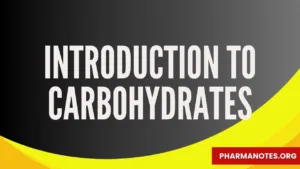Introduction to Carbohydrates

Objective
• At the end of this lecture, student will be able to
– Explain carbohydrates
– Classify carbohydrates
– Discuss the major pathways of carbohydrate metabolism
– Outline the functions of carbohydrate
Introduction to Carbohydrates
• Carbohydrates means hydrates of carbon
• Defined as polyhydroxy aldehydes or ketones or compounds which produce them on hydrolysis
• Soluble in water and sweet in taste
• These are most abundant organic molecules in nature
• Primarily composed of C, H, & O
Function
• Most abundant dietary source of energy (4 Cal/g)
• Precursors for many organic compounds (fats, amino acids)
• Participate in the structure of cell membrane and cellular functions such as cell growth, adhesion and fertilization
• Structural components of many organisms
Fiber (cellulose) of plants
Cell wall of microorganisms
• Serve as the storage form of energy (glycogen) to meet the immediate energy demands of the body
Classification of carbohydrates
Based on the number of sugar units – classified into 3 types
1. Monosaccharides
• These are simplest group of carbohydrates and are often referred as simple sugars
• General formula Cn(H20)n, & cannot be further hydrolysed
• Based on the functional group & number of carbon atoms, they are furthers classified into two types
a. Aldoses: here the functional group is aldehyde e.g. glyceraldehyde, glucose, erythrose etc
b. Ketoses: here the functional group is keto e.g. fructose
Based on the number of carbon atoms;
• Trioses (3C)
• Tetroses (4C)
• Pentoses (5C)
• Hexoses (6C)
• Heptoses (7C)
2. Oligosaccharides
• Contain 2-10 monosaccharide molecules which are liberated on hydrolysis
• Based on the number of monosaccharide units, further subdivided to
a. Disaccharides: sucrose, Lactose, maltose
b. Trisaccharides: Raffinose
c. Tetrasaccharides: Stachyose
3. Polysaccharides
• Polymers of monosaccharide units with high molecular weight
• Usually tasteless( non-sugars) and form colloids with water
• Polysaccharides are of two types
a. Homopolysaccharides: They contain single type of monosaccharide units e.g. Starch, Inulin, Glycogen, Dextrin.
b. Heteropolysaccharides: They possess two or more different type of monosaccharide units e.g. Heparin
• Carbohydrates are the major source of energy for the living cells
• They are the 1st cellular constituents synthesized by green plants during photosynthesis from CO2 &
H2O on absorption of light
• Glucose is the central molecule in carbohydrate metabolism since all the major pathways of carbohydrate metabolism are connected with it
• Fasting blood glucose level in normal individuals is 70-100 mg/dl
• Liver plays a key role in monitoring and stabilizing blood glucose levels
Dietary Importance of Carbohydrates
In human nutrition, carbohydrates are a major dietary energy source, providing approximately four calories per gram.
Common dietary sources of carbohydrates include grains, fruits, vegetables, legumes, and dairy products.
Dietary guidelines typically recommend consuming a balanced mix of carbohydrates, proteins, and fats to maintain optimal health, emphasizing whole grains, fruits, and vegetables for their fiber and nutrient content.
Major pathways of carbohydrate metabolism
1. Glycolysis: oxidation of glucose to pyruvate and lactate
2. Citric acid cycle: oxidation of acetyl CoA to CO2. it is the final common oxidative pathway for carbohydrates, fats or amino acids, through acetyl CoA
3. Gluconeogenesis: synthesis of glucose from non-carbohydrate precursors (e.g. amino acids, glycerol etc.)
4. Glycogenesis: formation of glycogen from glucose
5. Glycogenolysis: breakdown of glycogen to glucose
6. Hexose monophosphate shunt: This pathway is an alternative to glycolysis and TCA cycle for the oxidation of glucose (directly to carbon dioxide and water)
7. Uronic acid pathway: Glucose is converted to glucuronic acid, pentoses and in some animals to ascorbic acid (not in man) this pathway is also an alternative oxidative pathway for glucose
8. Galactose metabolism: Pathways concerned with the conversion of galactose to glucose and the synthesis of lactose
9. Fructose metabolism: Oxidation of fructose to pyruvate and the relation between fructose and glucose metabolism
10. Amino sugar and mucopolysaccharide metabolism: The synthesis of amino sugars and other sugars for the formation of mucopolysaccharides and glycoproteins
Summary
• Carbohydrates means hydrates of carbon
• Primarily composed of C, H, & O
• Based on the number of sugar units, they are classified into 3 types; monosaccharide, oligosaccharide and polysaccharides
• Based on the number of carbon atoms, they are classified as trioses, tetroses, pentoses, hexoses & heptoses
• Fasting blood glucose level in normal individuals is 70-100 mg/dl
• Major pathways of carbohydrate metabolism are glycolysis, TCA, gluconeogenesis, glycogenesis, glycogenolysis, HMP shunt, uronic acid pathway, galactose metabolism, Fructose metabolism & amino sugar and mucopolysaccharide metabolism
FAQs
- What are some examples of monosaccharides? Examples of monosaccharides include glucose, fructose, and galactose.
- How do carbohydrates contribute to energy production in cells? Carbohydrates are broken down into glucose, which is then metabolized through glycolysis and oxidative phosphorylation to produce ATP, the energy currency of cells.
- What is the recommended daily intake of carbohydrates? Dietary guidelines typically recommend that carbohydrates should comprise 45-65% of total daily caloric intake.
- Are all carbohydrates equally beneficial for health? Not all carbohydrates are equally beneficial. While complex carbohydrates from whole grains, fruits, and vegetables are generally health-promoting, excessive consumption of simple sugars and refined carbohydrates may have negative health effects.
- How does fiber in carbohydrates contribute to health? Dietary fiber, found in plant-based carbohydrates, promotes digestive health, helps regulate blood sugar levels, and may reduce the risk of cardiovascular disease and certain cancers.
Also, Visit:
B. Pharma Notes | B. Pharma Notes | Study material Bachelor of Pharmacy pdf




